Deck 18: The Keynesian Model
سؤال
سؤال
سؤال
سؤال
سؤال
سؤال
سؤال
سؤال
سؤال
سؤال
سؤال
سؤال
سؤال
سؤال
سؤال
سؤال
سؤال
سؤال
سؤال
سؤال
سؤال
سؤال
سؤال
سؤال
سؤال
سؤال
سؤال
سؤال
سؤال
سؤال
سؤال
سؤال
سؤال
سؤال
سؤال
سؤال
سؤال
سؤال
سؤال
سؤال
سؤال
سؤال
سؤال
سؤال
سؤال
سؤال
سؤال
سؤال
سؤال
سؤال
سؤال
سؤال
سؤال
سؤال
سؤال
سؤال
سؤال
سؤال
سؤال
سؤال
سؤال
سؤال
سؤال
سؤال
سؤال
سؤال
سؤال
سؤال
سؤال
سؤال
سؤال
سؤال
سؤال
سؤال
سؤال
سؤال
سؤال
سؤال
سؤال
سؤال

فتح الحزمة
قم بالتسجيل لفتح البطاقات في هذه المجموعة!
Unlock Deck
Unlock Deck
1/111
العب
ملء الشاشة (f)
Deck 18: The Keynesian Model
1
Classical economic theory predicted that in the long run the economy would experience:
A) below full unemployment.
B) rising rate of inflation.
C) full employment.
D) idle factors of production.
A) below full unemployment.
B) rising rate of inflation.
C) full employment.
D) idle factors of production.
C
2
If the economy were left on its own without the interference of government or the Fed, it would move toward an equilibrium rate of growth that would produce, with only minor interruptions, full employment without inflation. What school supports this view?
A) Classical.
B) Keynesian.
C) Monetarism.
D) Supply-side.
A) Classical.
B) Keynesian.
C) Monetarism.
D) Supply-side.
A
3
If the economy is experiencing less than full-employment, the Keynesian school recommends that the government:
A) do nothing to stimulate the economy.
B) undertake fiscal policy to stimulate aggregate demand.
C) undertake fiscal policy to stimulate aggregate supply.
D) balance the budget to stimulate aggregate demand.
A) do nothing to stimulate the economy.
B) undertake fiscal policy to stimulate aggregate demand.
C) undertake fiscal policy to stimulate aggregate supply.
D) balance the budget to stimulate aggregate demand.
B
4
The school of thought that emphasizes the natural tendency for an economy to move toward equilibrium full employment is known as the:
A) Keynesian school.
B) supply-side school.
C) rational expectations school.
D) classical school.
A) Keynesian school.
B) supply-side school.
C) rational expectations school.
D) classical school.

فتح الحزمة
افتح القفل للوصول البطاقات البالغ عددها 111 في هذه المجموعة.
فتح الحزمة
k this deck
5
According to John Maynard Keynes:
A) aggregate expenditures (demand) can be forever inadequate to achieve full employment.
B) aggregate output (supply) can be forever inadequate to achieve full employment.
C) the economy would automatically adjust to full employment in the long run.
D) neither aggregate demand nor aggregate supply is a determinant of full-employment real GDP.
A) aggregate expenditures (demand) can be forever inadequate to achieve full employment.
B) aggregate output (supply) can be forever inadequate to achieve full employment.
C) the economy would automatically adjust to full employment in the long run.
D) neither aggregate demand nor aggregate supply is a determinant of full-employment real GDP.

فتح الحزمة
افتح القفل للوصول البطاقات البالغ عددها 111 في هذه المجموعة.
فتح الحزمة
k this deck
6
Classical economists believed that:
A) price flexibility automatically directs market economies to full employment.
B) budget deficits and surpluses were necessary for the control of economic fluctuations.
C) market economies suffer prolonged periods of recessions and depressions.
D) market economies are inherently unstable because of fluctuating aggregate demand.
A) price flexibility automatically directs market economies to full employment.
B) budget deficits and surpluses were necessary for the control of economic fluctuations.
C) market economies suffer prolonged periods of recessions and depressions.
D) market economies are inherently unstable because of fluctuating aggregate demand.

فتح الحزمة
افتح القفل للوصول البطاقات البالغ عددها 111 في هذه المجموعة.
فتح الحزمة
k this deck
7
The consumption function shows the relationship between:
A) planned consumption expenditures and disposable income.
B) permanent income and savings.
C) business inventory and real GDP.
D) aggregate demand and aggregate consumption.
A) planned consumption expenditures and disposable income.
B) permanent income and savings.
C) business inventory and real GDP.
D) aggregate demand and aggregate consumption.

فتح الحزمة
افتح القفل للوصول البطاقات البالغ عددها 111 في هذه المجموعة.
فتح الحزمة
k this deck
8
The French economist Jean-Baptiste Say transformed the equality of total output and total spending into a law that can be expressed as follows:
A) Unemployment is not possible in the short run.
B) Demand and supply are never equal.
C) Supply creates its own demand.
D) Demand creates its own supply.
A) Unemployment is not possible in the short run.
B) Demand and supply are never equal.
C) Supply creates its own demand.
D) Demand creates its own supply.

فتح الحزمة
افتح القفل للوصول البطاقات البالغ عددها 111 في هذه المجموعة.
فتح الحزمة
k this deck
9
Keynes once remarked that, in the long run, we're all dead. He was responding to the conventional wisdom of classical economics who argued that:
A) the supply curve should remain vertical in the long run.
B) World War I was fought to free Britain from economic ruin.
C) the depression was only a short-run, temporary departure from full-employment equilibrium.
D) market-based realities cause the estate tax to be too high.
A) the supply curve should remain vertical in the long run.
B) World War I was fought to free Britain from economic ruin.
C) the depression was only a short-run, temporary departure from full-employment equilibrium.
D) market-based realities cause the estate tax to be too high.

فتح الحزمة
افتح القفل للوصول البطاقات البالغ عددها 111 في هذه المجموعة.
فتح الحزمة
k this deck
10
John Maynard Keynes and his followers argued that the Great Depression was primarily the result of:
A) excessive government spending.
B) large budget deficits.
C) the perverse monetary policies of the Fed.
D) insufficient aggregate spending on goods and services.
A) excessive government spending.
B) large budget deficits.
C) the perverse monetary policies of the Fed.
D) insufficient aggregate spending on goods and services.

فتح الحزمة
افتح القفل للوصول البطاقات البالغ عددها 111 في هذه المجموعة.
فتح الحزمة
k this deck
11
According to Say's law, there cannot be overproduction of goods and services because:
A) planned aggregate expenditures sometimes fall short of total output.
B) prices and wages are "sticky" or inflexible in the downward direction.
C) demand creates its own supply.
D) supply creates its own demand.
A) planned aggregate expenditures sometimes fall short of total output.
B) prices and wages are "sticky" or inflexible in the downward direction.
C) demand creates its own supply.
D) supply creates its own demand.

فتح الحزمة
افتح القفل للوصول البطاقات البالغ عددها 111 في هذه المجموعة.
فتح الحزمة
k this deck
12
Prior to the Great Depression, classical economists believed that a recessionary downturn would be reversed by:
A) higher wages and prices.
B) lower wages and prices.
C) an expansionary monetary policy on the part of the Federal Reserve System.
D) an increase in government spending that would stimulate aggregate demand.
A) higher wages and prices.
B) lower wages and prices.
C) an expansionary monetary policy on the part of the Federal Reserve System.
D) an increase in government spending that would stimulate aggregate demand.

فتح الحزمة
افتح القفل للوصول البطاقات البالغ عددها 111 في هذه المجموعة.
فتح الحزمة
k this deck
13
The hands-off view of the classical school rests on which of the following two simple propositions about markets?
A) Demand creates its own supply and markets are basically competitive.
B) Markets are basically competitive and prices are flexible.
C) Market failure occurs and prices are rigid.
D) Wages are sticky downward and market failure is inevitable.
A) Demand creates its own supply and markets are basically competitive.
B) Markets are basically competitive and prices are flexible.
C) Market failure occurs and prices are rigid.
D) Wages are sticky downward and market failure is inevitable.

فتح الحزمة
افتح القفل للوصول البطاقات البالغ عددها 111 في هذه المجموعة.
فتح الحزمة
k this deck
14
The most appropriate countercyclical policy, or stabilization policy, in times of unemployment, according to classical economists, is for the government to:
A) increase the minimum wage.
B) do nothing.
C) stimulate aggregate demand.
D) cut taxes.
A) increase the minimum wage.
B) do nothing.
C) stimulate aggregate demand.
D) cut taxes.

فتح الحزمة
افتح القفل للوصول البطاقات البالغ عددها 111 في هذه المجموعة.
فتح الحزمة
k this deck
15
The popular theory prior to the Great Depression that the economy will automatically adjust to achieve full employment in the long run is:
A) supply-side economics.
B) Keynesian economics.
C) classical economics.
D) mercantilism
A) supply-side economics.
B) Keynesian economics.
C) classical economics.
D) mercantilism

فتح الحزمة
افتح القفل للوصول البطاقات البالغ عددها 111 في هذه المجموعة.
فتح الحزمة
k this deck
16
Keynesians:
A) accept the countercyclical policy of doing nothing, that is, allowing market forces to work.
B) believe that the level of aggregate demand in the 1930s was sufficient to generate full employment.
C) accept the fact that policymakers should eliminate inflation first before focusing on unemployment.
D) focus on increasing aggregate demand in order to stimulate the economy.
A) accept the countercyclical policy of doing nothing, that is, allowing market forces to work.
B) believe that the level of aggregate demand in the 1930s was sufficient to generate full employment.
C) accept the fact that policymakers should eliminate inflation first before focusing on unemployment.
D) focus on increasing aggregate demand in order to stimulate the economy.

فتح الحزمة
افتح القفل للوصول البطاقات البالغ عددها 111 في هذه المجموعة.
فتح الحزمة
k this deck
17
The dominant school of economic thought until midway through the Great Depression of the 1930s was:
A) classical.
B) Keynesian.
C) monetarism.
D) supply-side.
A) classical.
B) Keynesian.
C) monetarism.
D) supply-side.

فتح الحزمة
افتح القفل للوصول البطاقات البالغ عددها 111 في هذه المجموعة.
فتح الحزمة
k this deck
18
According to Keynes, what is the most important determinant of households' spending on goods and services?
A) the price level
B) the interest rate
C) autonomous consumption
D) disposable income
A) the price level
B) the interest rate
C) autonomous consumption
D) disposable income

فتح الحزمة
افتح القفل للوصول البطاقات البالغ عددها 111 في هذه المجموعة.
فتح الحزمة
k this deck
19
Keynesian economics:
A) affirms the classical economists' basic premise concerning competitive markets.
B) believes that monopolies and unions tend to be permanent fixtures in our economy and the prices they create tend to be flexible, at least downwardly.
C) emphasizes the possibility that an economy can never be in equilibrium at less than full employment.
D) believes that unemployment results when aggregate demand is insufficient to reach a full-employment level of real GDP.
A) affirms the classical economists' basic premise concerning competitive markets.
B) believes that monopolies and unions tend to be permanent fixtures in our economy and the prices they create tend to be flexible, at least downwardly.
C) emphasizes the possibility that an economy can never be in equilibrium at less than full employment.
D) believes that unemployment results when aggregate demand is insufficient to reach a full-employment level of real GDP.

فتح الحزمة
افتح القفل للوصول البطاقات البالغ عددها 111 في هذه المجموعة.
فتح الحزمة
k this deck
20
A primary emphasis of the Keynesian school is the economy has a tendency to:
A) always create a full-employment level of output.
B) always create inflationary pressure at all levels of output.
C) eliminate unemployment by lowering wage rates to create an equilibrium in the labor market.
D) be in equilibrium at less than full employment.
A) always create a full-employment level of output.
B) always create inflationary pressure at all levels of output.
C) eliminate unemployment by lowering wage rates to create an equilibrium in the labor market.
D) be in equilibrium at less than full employment.

فتح الحزمة
افتح القفل للوصول البطاقات البالغ عددها 111 في هذه المجموعة.
فتح الحزمة
k this deck
21
If, for a given disposable income level, the disposable income line lies below the consumption curve, saving:
A) equals consumption.
B) equals disposable income.
C) is less than zero.
D) is greater than zero.
A) equals consumption.
B) equals disposable income.
C) is less than zero.
D) is greater than zero.

فتح الحزمة
افتح القفل للوصول البطاقات البالغ عددها 111 في هذه المجموعة.
فتح الحزمة
k this deck
22
If your disposable income increases from $30,000 to $35,000 and your consumption increases from $11,000 to $12,000, your marginal propensity to consume (MPC) is:
A) 0.2.
B) 0.4.
C) 0.5.
D) 0.8.
A) 0.2.
B) 0.4.
C) 0.5.
D) 0.8.

فتح الحزمة
افتح القفل للوصول البطاقات البالغ عددها 111 في هذه المجموعة.
فتح الحزمة
k this deck
23
When economists say that private investment is "autonomous," they mean that it:
A) will never change.
B) is not dependent on the current level of disposable income.
C) is determined by the "animal spirits" of business decision makers.
D) is determined by the level of saving.
A) will never change.
B) is not dependent on the current level of disposable income.
C) is determined by the "animal spirits" of business decision makers.
D) is determined by the level of saving.

فتح الحزمة
افتح القفل للوصول البطاقات البالغ عددها 111 في هذه المجموعة.
فتح الحزمة
k this deck
24
The nation has its own MPC. When disposable income increases from $300 billion to $400 billion, national consumption increases from $300 billion to $360 billion. At Y = $400 billion, the MPC is:
A) 0.2.
B) 0.5.
C) 0.6.
D) 0.67.
A) 0.2.
B) 0.5.
C) 0.6.
D) 0.67.

فتح الحزمة
افتح القفل للوصول البطاقات البالغ عددها 111 في هذه المجموعة.
فتح الحزمة
k this deck
25
If, for a given disposable income level, the disposable income line lies above the consumption curve, saving:
A) equals consumption.
B) is greater than zero.
C) is less than zero.
D) is equal to zero.
A) equals consumption.
B) is greater than zero.
C) is less than zero.
D) is equal to zero.

فتح الحزمة
افتح القفل للوصول البطاقات البالغ عددها 111 في هذه المجموعة.
فتح الحزمة
k this deck
26
If disposable income is $400 billion, consumption spending is $380 billion, and MPC is 0.5, what is the level of saving?
A) $20 billion.
B) $210 billion.
C) $380 billion.
D) $590 billion.
A) $20 billion.
B) $210 billion.
C) $380 billion.
D) $590 billion.

فتح الحزمة
افتح القفل للوصول البطاقات البالغ عددها 111 في هذه المجموعة.
فتح الحزمة
k this deck
27
If Y = $500 billion, autonomous consumption = $400 billion, and the marginal propensity to save = 0.20, then saving will equal:
A) − $300 billion.
B) $300 billion.
C) -$80 billion.
D) $80 billion.
A) − $300 billion.
B) $300 billion.
C) -$80 billion.
D) $80 billion.

فتح الحزمة
افتح القفل للوصول البطاقات البالغ عددها 111 في هذه المجموعة.
فتح الحزمة
k this deck
28
If real disposable income increases from $110,000 to $120,000 and consumption increases from $108,000 to $114,000, the marginal propensity to consume is:
A) 0.40.
B) 0.60.
C) 0.94.
D) 1.60.
A) 0.40.
B) 0.60.
C) 0.94.
D) 1.60.

فتح الحزمة
افتح القفل للوصول البطاقات البالغ عددها 111 في هذه المجموعة.
فتح الحزمة
k this deck
29
John Maynard Keynes's central proposition that a dollar increase in disposable income would increase consumption, but by less than the increase in disposable income, means the marginal propensity to consume (MPC) is:
A) greater than or equal to one.
B) equal to one.
C) less than one, but greater than zero.
D) negative.
A) greater than or equal to one.
B) equal to one.
C) less than one, but greater than zero.
D) negative.

فتح الحزمة
افتح القفل للوصول البطاقات البالغ عددها 111 في هذه المجموعة.
فتح الحزمة
k this deck
30
The marginal propensity to consume (MPC) is the slope of the:
A) GDP curve.
B) disposable income curve.
C) consumption function.
D) autonomous consumption curve.
A) GDP curve.
B) disposable income curve.
C) consumption function.
D) autonomous consumption curve.

فتح الحزمة
افتح القفل للوصول البطاقات البالغ عددها 111 في هذه المجموعة.
فتح الحزمة
k this deck
31
A movement along the consumption function is caused by a change in:
A) consumption.
B) expectations.
C) aggregate supply.
D) disposable income.
A) consumption.
B) expectations.
C) aggregate supply.
D) disposable income.

فتح الحزمة
افتح القفل للوصول البطاقات البالغ عددها 111 في هذه المجموعة.
فتح الحزمة
k this deck
32
That part of disposable income not spent on consumption is defined as:
A) transitory disposable income.
B) permanent disposable income.
C) saving.
D) autonomous consumption.
A) transitory disposable income.
B) permanent disposable income.
C) saving.
D) autonomous consumption.

فتح الحزمة
افتح القفل للوصول البطاقات البالغ عددها 111 في هذه المجموعة.
فتح الحزمة
k this deck
33
The marginal propensity to consume is defined as the:
A) fraction of total income not spent on consumption.
B) proportion of any change in income that is spent on consumption.
C) fraction of total income spent on consumption.
D) fraction of a change in income that is saved.
A) fraction of total income not spent on consumption.
B) proportion of any change in income that is spent on consumption.
C) fraction of total income spent on consumption.
D) fraction of a change in income that is saved.

فتح الحزمة
افتح القفل للوصول البطاقات البالغ عددها 111 في هذه المجموعة.
فتح الحزمة
k this deck
34
The consumption function shows the relationship between consumer expenditures and:
A) the interest rate.
B) the tax rate.
C) savings.
D) disposable income.
A) the interest rate.
B) the tax rate.
C) savings.
D) disposable income.

فتح الحزمة
افتح القفل للوصول البطاقات البالغ عددها 111 في هذه المجموعة.
فتح الحزمة
k this deck
35
If consumption spending is larger than disposable income,
A) saving is positive.
B) dissaving occurs.
C) saving is exactly zero.
D) a depression results.
A) saving is positive.
B) dissaving occurs.
C) saving is exactly zero.
D) a depression results.

فتح الحزمة
افتح القفل للوصول البطاقات البالغ عددها 111 في هذه المجموعة.
فتح الحزمة
k this deck
36
Consider the Keynesian consumption function. If disposable income is greater than the break-even level of disposable income, then households will be:
A) investing.
B) borrowing.
C) dissaving.
D) saving.
A) investing.
B) borrowing.
C) dissaving.
D) saving.

فتح الحزمة
افتح القفل للوصول البطاقات البالغ عددها 111 في هذه المجموعة.
فتح الحزمة
k this deck
37
The vertical intercept of the consumption function that represents the portion of consumption expenditure not associated with a level of disposable income is known as:
A) zero income intercept.
B) disposable income intercept.
C) autonomous consumption.
D) automatic consumption line.
A) zero income intercept.
B) disposable income intercept.
C) autonomous consumption.
D) automatic consumption line.

فتح الحزمة
افتح القفل للوصول البطاقات البالغ عددها 111 في هذه المجموعة.
فتح الحزمة
k this deck
38
If disposable income is $400 billion, autonomous consumption is $60 billion, and MPC is 0.8, what is the level of saving?
A) $20 billion.
B) $210 billion.
C) $380 billion.
D) $590 billion.
A) $20 billion.
B) $210 billion.
C) $380 billion.
D) $590 billion.

فتح الحزمة
افتح القفل للوصول البطاقات البالغ عددها 111 في هذه المجموعة.
فتح الحزمة
k this deck
39
That part of disposable income not spent on consumption is:
A) saved.
B) invested.
C) wasted.
D) borrowed.
A) saved.
B) invested.
C) wasted.
D) borrowed.

فتح الحزمة
افتح القفل للوصول البطاقات البالغ عددها 111 في هذه المجموعة.
فتح الحزمة
k this deck
40
Exhibit 8-1 Disposable income and consumption data
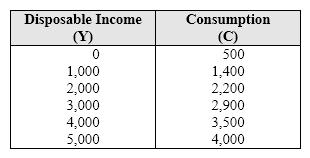
In Exhibit 8-1, when disposable income (Y) is increased from $1,000 to $2,000, the marginal propensity to consume is:
A) 0.2.
B) 0.6.
C) 0.8.
D) 1.0.

In Exhibit 8-1, when disposable income (Y) is increased from $1,000 to $2,000, the marginal propensity to consume is:
A) 0.2.
B) 0.6.
C) 0.8.
D) 1.0.

فتح الحزمة
افتح القفل للوصول البطاقات البالغ عددها 111 في هذه المجموعة.
فتح الحزمة
k this deck
41
Exhibit 8-2 Consumption function
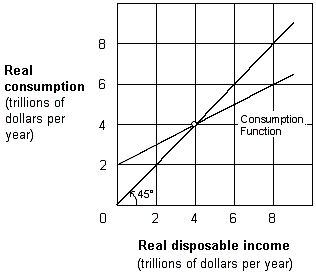
As shown in Exhibit 8-2, saving occurs:
A) at 0 disposable income.
B) between $0 and $4 trillion disposable income.
C) at $4 trillion disposable income.
D) at a disposable income greater than $4 trillion.

As shown in Exhibit 8-2, saving occurs:
A) at 0 disposable income.
B) between $0 and $4 trillion disposable income.
C) at $4 trillion disposable income.
D) at a disposable income greater than $4 trillion.

فتح الحزمة
افتح القفل للوصول البطاقات البالغ عددها 111 في هذه المجموعة.
فتح الحزمة
k this deck
42
Exhibit 8-8 Consumption function

In Exhibit 8-8, which of the following could cause the movement from C1 to C2?
A) a decrease in real asset holdings
B) lower interest rates
C) expectations that the economy will grow
D) expectations of lower future prices

In Exhibit 8-8, which of the following could cause the movement from C1 to C2?
A) a decrease in real asset holdings
B) lower interest rates
C) expectations that the economy will grow
D) expectations of lower future prices

فتح الحزمة
افتح القفل للوصول البطاقات البالغ عددها 111 في هذه المجموعة.
فتح الحزمة
k this deck
43
Exhibit 8-2 Consumption function
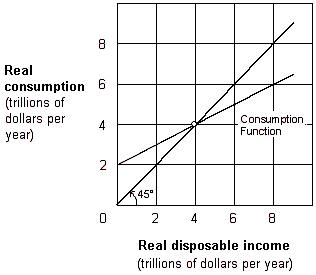
As shown in Exhibit 8-2, dissaving occurs:
A) at $5 trillion.
B) between 0 and $4 trillion.
C) where disposable income is greater than $4 trillion.
D) at $8 trillion.

As shown in Exhibit 8-2, dissaving occurs:
A) at $5 trillion.
B) between 0 and $4 trillion.
C) where disposable income is greater than $4 trillion.
D) at $8 trillion.

فتح الحزمة
افتح القفل للوصول البطاقات البالغ عددها 111 في هذه المجموعة.
فتح الحزمة
k this deck
44
If the marginal propensity to consume = 0.75, then:
A) the marginal propensity to save = 0.75.
B) the marginal propensity to save = 0.25
C) the marginal propensity to save = 0.20.
D) since the marginal propensity to save and the marginal propensity to consume are unrelated, we cannot determine the marginal propensity to save from the information given.
A) the marginal propensity to save = 0.75.
B) the marginal propensity to save = 0.25
C) the marginal propensity to save = 0.20.
D) since the marginal propensity to save and the marginal propensity to consume are unrelated, we cannot determine the marginal propensity to save from the information given.

فتح الحزمة
افتح القفل للوصول البطاقات البالغ عددها 111 في هذه المجموعة.
فتح الحزمة
k this deck
45
The sum of the marginal propensity to consume (MPC) and the marginal propensity to save (MPS) always equals:
A) 1.
B) 0.
C) the interest rate.
D) the marginal propensity to invest (MPI).
A) 1.
B) 0.
C) the interest rate.
D) the marginal propensity to invest (MPI).

فتح الحزمة
افتح القفل للوصول البطاقات البالغ عددها 111 في هذه المجموعة.
فتح الحزمة
k this deck
46
Exhibit 8-1 Disposable income and consumption data
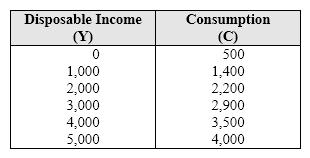
In Exhibit 8-1, when disposable income (Y) is increased from $0 to $1,000 to $2,000, the marginal propensity to consume:
A) is negative.
B) decreases from 0.9 to 0.8.
C) decreases from 0.8 to 0.7.
D) increases from 0.8 to 0.9.

In Exhibit 8-1, when disposable income (Y) is increased from $0 to $1,000 to $2,000, the marginal propensity to consume:
A) is negative.
B) decreases from 0.9 to 0.8.
C) decreases from 0.8 to 0.7.
D) increases from 0.8 to 0.9.

فتح الحزمة
افتح القفل للوصول البطاقات البالغ عددها 111 في هذه المجموعة.
فتح الحزمة
k this deck
47
Exhibit 8-2 Consumption function
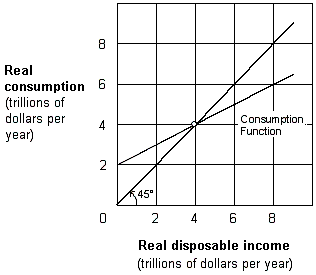
As shown in Exhibit 8-2, the 45 0 line represents:
A) autonomous consumption.
B) real consumption spending.
C) real disposable income.
D) all points where real consumption equals real disposable income.

As shown in Exhibit 8-2, the 45 0 line represents:
A) autonomous consumption.
B) real consumption spending.
C) real disposable income.
D) all points where real consumption equals real disposable income.

فتح الحزمة
افتح القفل للوصول البطاقات البالغ عددها 111 في هذه المجموعة.
فتح الحزمة
k this deck
48
Exhibit 8-6 Consumption function
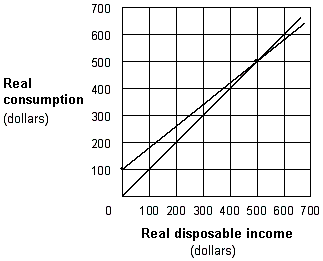
In Exhibit 8-6, when disposable income is equal to zero, saving is equal to:
A) $0.
B) $100.
C) − $50.
D) − $100.

In Exhibit 8-6, when disposable income is equal to zero, saving is equal to:
A) $0.
B) $100.
C) − $50.
D) − $100.

فتح الحزمة
افتح القفل للوصول البطاقات البالغ عددها 111 في هذه المجموعة.
فتح الحزمة
k this deck
49
Exhibit 8-2 Consumption function

As shown in Exhibit 8-2, autonomous consumption is:
A) 0.
B) $2 trillion.
C) $4 trillion.
D) $6 trillion.

As shown in Exhibit 8-2, autonomous consumption is:
A) 0.
B) $2 trillion.
C) $4 trillion.
D) $6 trillion.

فتح الحزمة
افتح القفل للوصول البطاقات البالغ عددها 111 في هذه المجموعة.
فتح الحزمة
k this deck
50
Exhibit 8-7 Consumption function
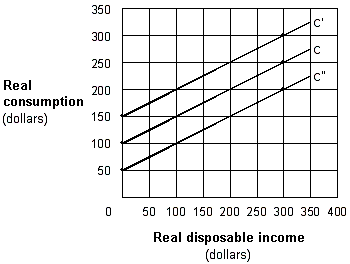
In Exhibit 8-7, the value of the marginal propensity to consume is:
A) high for C' than for C.
B) lower for C" than for C.
C) lower for C" than for C'.
D) the same for C, C', and C".

In Exhibit 8-7, the value of the marginal propensity to consume is:
A) high for C' than for C.
B) lower for C" than for C.
C) lower for C" than for C'.
D) the same for C, C', and C".

فتح الحزمة
افتح القفل للوصول البطاقات البالغ عددها 111 في هذه المجموعة.
فتح الحزمة
k this deck
51
Which of the following events would produce an upward shift in the consumption function, other things being equal?
A) an increase in consumer wealth
B) a decrease in consumer wealth
C) a decrease in autonomous consumption
D) an increase in the interest rate
A) an increase in consumer wealth
B) a decrease in consumer wealth
C) a decrease in autonomous consumption
D) an increase in the interest rate

فتح الحزمة
افتح القفل للوصول البطاقات البالغ عددها 111 في هذه المجموعة.
فتح الحزمة
k this deck
52
What are the marginal propensity to consume (MPC) and the marginal propensity to save (MPS)? How is the MPC related to the consumption function?

فتح الحزمة
افتح القفل للوصول البطاقات البالغ عددها 111 في هذه المجموعة.
فتح الحزمة
k this deck
53
Explain why the marginal propensity to save and the marginal propensity to consume sum to 1.

فتح الحزمة
افتح القفل للوصول البطاقات البالغ عددها 111 في هذه المجموعة.
فتح الحزمة
k this deck
54
If your disposable personal income increases from $30,000 to $40,000 and your savings increases from $2,000 to $4,000, your marginal propensity to save (MPS) is:
A) 0.2.
B) 0.4.
C) 0.5.
D) 0.8.
A) 0.2.
B) 0.4.
C) 0.5.
D) 0.8.

فتح الحزمة
افتح القفل للوصول البطاقات البالغ عددها 111 في هذه المجموعة.
فتح الحزمة
k this deck
55
Exhibit 8-6 Consumption function
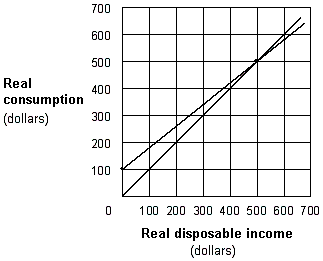
In Exhibit 8-6, the level of autonomous consumption is:
A) $100.
B) $150.
C) $50.
D) $0.

In Exhibit 8-6, the level of autonomous consumption is:
A) $100.
B) $150.
C) $50.
D) $0.

فتح الحزمة
افتح القفل للوصول البطاقات البالغ عددها 111 في هذه المجموعة.
فتح الحزمة
k this deck
56
Exhibit 8-1 Disposable income and consumption data
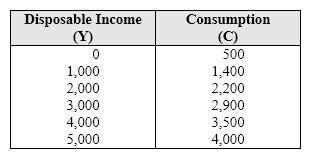
In Exhibit 8-1, when disposable income is increased from $2,000 to $3,000 to $4,000, the marginal propensity to consume
A) remains constant.
B) increases from 0.6 to 0.7.
C) decreases from 0.8 to 0.7.
D) decreases from 0.7 to 0.6.

In Exhibit 8-1, when disposable income is increased from $2,000 to $3,000 to $4,000, the marginal propensity to consume
A) remains constant.
B) increases from 0.6 to 0.7.
C) decreases from 0.8 to 0.7.
D) decreases from 0.7 to 0.6.

فتح الحزمة
افتح القفل للوصول البطاقات البالغ عددها 111 في هذه المجموعة.
فتح الحزمة
k this deck
57
Exhibit 8-8 Consumption function
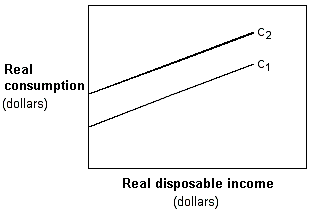
In Exhibit 8-8, which of the following could cause the movement from C1 to C2?
A) higher wealth
B) higher interest rates
C) higher taxes
D) a technological breakthrough

In Exhibit 8-8, which of the following could cause the movement from C1 to C2?
A) higher wealth
B) higher interest rates
C) higher taxes
D) a technological breakthrough

فتح الحزمة
افتح القفل للوصول البطاقات البالغ عددها 111 في هذه المجموعة.
فتح الحزمة
k this deck
58
Exhibit 8-7 Consumption function
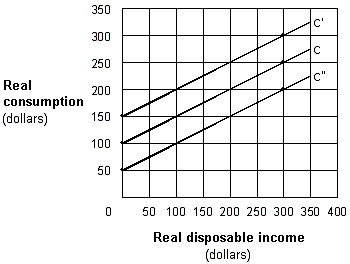
In Exhibit 8-7, the shift from C to C' could be caused by a(n):
A) increase in disposable income.
B) expectation of inflation.
C) increase in interest rates.
D) increase in the level of saving.

In Exhibit 8-7, the shift from C to C' could be caused by a(n):
A) increase in disposable income.
B) expectation of inflation.
C) increase in interest rates.
D) increase in the level of saving.

فتح الحزمة
افتح القفل للوصول البطاقات البالغ عددها 111 في هذه المجموعة.
فتح الحزمة
k this deck
59
Exhibit 8-2 Consumption function
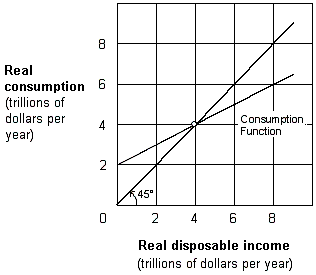
As shown in Exhibit 8-2, the marginal propensity to consume (MPC) is:
A) 0.25.
B) 0.50.
C) 0.75.
D) 0.90.

As shown in Exhibit 8-2, the marginal propensity to consume (MPC) is:
A) 0.25.
B) 0.50.
C) 0.75.
D) 0.90.

فتح الحزمة
افتح القفل للوصول البطاقات البالغ عددها 111 في هذه المجموعة.
فتح الحزمة
k this deck
60
The marginal propensity to save is:
A) the change in saving divided by the change in disposable income.
B) the change in disposable income divided by the change in saving.
C) saving divided by disposable income.
D) disposable income divided by saving.
A) the change in saving divided by the change in disposable income.
B) the change in disposable income divided by the change in saving.
C) saving divided by disposable income.
D) disposable income divided by saving.

فتح الحزمة
افتح القفل للوصول البطاقات البالغ عددها 111 في هذه المجموعة.
فتح الحزمة
k this deck
61
Which one of the following will shift the consumption function downward?
A) an increase in disposable income
B) a decrease in disposable income
C) legislation making credit harder to obtain
D) lower tax rates
A) an increase in disposable income
B) a decrease in disposable income
C) legislation making credit harder to obtain
D) lower tax rates

فتح الحزمة
افتح القفل للوصول البطاقات البالغ عددها 111 في هذه المجموعة.
فتح الحزمة
k this deck
62
The consumption function will shift for all of the following reasons except:
A) a change in a household's real assets.
B) a change in interest rates.
C) expectations of price changes.
D) changes in a household's disposable incomes.
A) a change in a household's real assets.
B) a change in interest rates.
C) expectations of price changes.
D) changes in a household's disposable incomes.

فتح الحزمة
افتح القفل للوصول البطاقات البالغ عددها 111 في هذه المجموعة.
فتح الحزمة
k this deck
63
Which of the following will shift the consumption function upward?
A) a tax increase
B) expectations of inflation
C) higher disposable income
D) lower wealth holdings
A) a tax increase
B) expectations of inflation
C) higher disposable income
D) lower wealth holdings

فتح الحزمة
افتح القفل للوصول البطاقات البالغ عددها 111 في هذه المجموعة.
فتح الحزمة
k this deck
64
If people expect prices to fall in the future,
A) their consumption function in the present will shift downward.
B) their consumption function in the present will shift upward.
C) they will decrease their current levels of consumption by moving down along their consumption functions.
D) they will increase their current levels of consumption by moving up along their consumption functions.
A) their consumption function in the present will shift downward.
B) their consumption function in the present will shift upward.
C) they will decrease their current levels of consumption by moving down along their consumption functions.
D) they will increase their current levels of consumption by moving up along their consumption functions.

فتح الحزمة
افتح القفل للوصول البطاقات البالغ عددها 111 في هذه المجموعة.
فتح الحزمة
k this deck
65
An upward shift in the consumption function, other things being equal, could be caused by households:
A) becoming optimistic about the state of the economy.
B) becoming pessimistic about the state of the economy.
C) expecting future income and wealth to decline.
D) experiencing a tax increase.
A) becoming optimistic about the state of the economy.
B) becoming pessimistic about the state of the economy.
C) expecting future income and wealth to decline.
D) experiencing a tax increase.

فتح الحزمة
افتح القفل للوصول البطاقات البالغ عددها 111 في هذه المجموعة.
فتح الحزمة
k this deck
66
A movement along a consumption function is caused by:
A) a change in households' real assets.
B) a change in interest rates.
C) changes in households' disposable incomes.
D) expectations of price changes.
A) a change in households' real assets.
B) a change in interest rates.
C) changes in households' disposable incomes.
D) expectations of price changes.

فتح الحزمة
افتح القفل للوصول البطاقات البالغ عددها 111 في هذه المجموعة.
فتح الحزمة
k this deck
67
An increase in the price level, other things remaining the same, may be expected to result in ____ the consumption function.
A) a downward shift of
B) a movement along
C) an upward shift in
D) no effect on
A) a downward shift of
B) a movement along
C) an upward shift in
D) no effect on

فتح الحزمة
افتح القفل للوصول البطاقات البالغ عددها 111 في هذه المجموعة.
فتح الحزمة
k this deck
68
If the interest rate increases, then the:
A) economy will move to a new point along the existing consumption function.
B) consumption function will shift up.
C) consumption function will shift down.
D) investment demand curve will shift up.
A) economy will move to a new point along the existing consumption function.
B) consumption function will shift up.
C) consumption function will shift down.
D) investment demand curve will shift up.

فتح الحزمة
افتح القفل للوصول البطاقات البالغ عددها 111 في هذه المجموعة.
فتح الحزمة
k this deck
69
A shift in the consumption function:
A) is based on the marginal propensity to consume.
B) can be caused by a change in the price level.
C) can be caused by a change in GDP.
D) cannot be caused by a change in expectations.
A) is based on the marginal propensity to consume.
B) can be caused by a change in the price level.
C) can be caused by a change in GDP.
D) cannot be caused by a change in expectations.

فتح الحزمة
افتح القفل للوصول البطاقات البالغ عددها 111 في هذه المجموعة.
فتح الحزمة
k this deck
70
If people's real assets increase, then the:
A) economy will move to the right along the existing consumption function.
B) economy will move to the left along the existing consumption function.
C) consumption function will shift down.
D) consumption function will shift up.
A) economy will move to the right along the existing consumption function.
B) economy will move to the left along the existing consumption function.
C) consumption function will shift down.
D) consumption function will shift up.

فتح الحزمة
افتح القفل للوصول البطاقات البالغ عددها 111 في هذه المجموعة.
فتح الحزمة
k this deck
71
Which one of the following changes is consistent with a change in an economy's consumption function from C = $500 billion + 0.80Y to C = $700 billion + 0.80Y?
A) An increase in disposable income taxes.
B) An increase in interest rates
C) A decrease in permanent disposable income.
D) An increase in wealth.
A) An increase in disposable income taxes.
B) An increase in interest rates
C) A decrease in permanent disposable income.
D) An increase in wealth.

فتح الحزمة
افتح القفل للوصول البطاقات البالغ عددها 111 في هذه المجموعة.
فتح الحزمة
k this deck
72
Which of the following will shift the consumption function upward?
A) an increase in consumer wealth
B) an increase in disposable income
C) an increase in personal income taxes
D) a decrease in the MPC
A) an increase in consumer wealth
B) an increase in disposable income
C) an increase in personal income taxes
D) a decrease in the MPC

فتح الحزمة
افتح القفل للوصول البطاقات البالغ عددها 111 في هذه المجموعة.
فتح الحزمة
k this deck
73
Which one of the following will shift the consumption function upward?
A) higher interest rates
B) an increase in real assets
C) expectations of future economic growth
D) lower capacity utilization rates
A) higher interest rates
B) an increase in real assets
C) expectations of future economic growth
D) lower capacity utilization rates

فتح الحزمة
افتح القفل للوصول البطاقات البالغ عددها 111 في هذه المجموعة.
فتح الحزمة
k this deck
74
The consumption function will shift upward if real asset and money holdings:
A) increase, if people expect prices to increase, if interest rates decrease, and if taxes decrease.
B) increase, if people expect prices to increase, if interest rates increase, and if taxes increase.
C) increase, if people expect prices to increase, if interest rates increase, and if taxes decrease.
D) decrease, if people expect prices to decrease, if interest rates decrease, and if taxes decrease.
A) increase, if people expect prices to increase, if interest rates decrease, and if taxes decrease.
B) increase, if people expect prices to increase, if interest rates increase, and if taxes increase.
C) increase, if people expect prices to increase, if interest rates increase, and if taxes decrease.
D) decrease, if people expect prices to decrease, if interest rates decrease, and if taxes decrease.

فتح الحزمة
افتح القفل للوصول البطاقات البالغ عددها 111 في هذه المجموعة.
فتح الحزمة
k this deck
75
A movement along in the consumption function is caused by a change in:
A) real disposable income.
B) can be caused by a change in the price level.
C) the marginal propensity to consume (MPC).
D) consumer wealth.
A) real disposable income.
B) can be caused by a change in the price level.
C) the marginal propensity to consume (MPC).
D) consumer wealth.

فتح الحزمة
افتح القفل للوصول البطاقات البالغ عددها 111 في هذه المجموعة.
فتح الحزمة
k this deck
76
Given the consumption function C = $500 billion + 0.80Y, an increase in disposable income from $6,000 billion to $7,000 billion will cause consumption to increase by:
A) $800 billion.
B) $1,000 billion.
C) $1,300 billion.
D) $1,500 billion.
A) $800 billion.
B) $1,000 billion.
C) $1,300 billion.
D) $1,500 billion.

فتح الحزمة
افتح القفل للوصول البطاقات البالغ عددها 111 في هذه المجموعة.
فتح الحزمة
k this deck
77
Which one of the following will shift the consumption function upward?
A) higher interest rates
B) expectations that the economy will grow in the future
C) a decrease in money holdings
D) higher capacity utilization rates
A) higher interest rates
B) expectations that the economy will grow in the future
C) a decrease in money holdings
D) higher capacity utilization rates

فتح الحزمة
افتح القفل للوصول البطاقات البالغ عددها 111 في هذه المجموعة.
فتح الحزمة
k this deck
78
A downward shift in the consumption function can be caused by:
A) expectations of higher inflation.
B) an increase in wealth.
C) a lower price level.
D) an increase in autonomous consumption.
A) expectations of higher inflation.
B) an increase in wealth.
C) a lower price level.
D) an increase in autonomous consumption.

فتح الحزمة
افتح القفل للوصول البطاقات البالغ عددها 111 في هذه المجموعة.
فتح الحزمة
k this deck
79
Which of the following events would produce an upward shift in the consumption function, other things being equal?
A) an increase in consumer wealth
B) a decrease in consumer wealth
C) a decrease in autonomous consumption
D) an increase in the price level
A) an increase in consumer wealth
B) a decrease in consumer wealth
C) a decrease in autonomous consumption
D) an increase in the price level

فتح الحزمة
افتح القفل للوصول البطاقات البالغ عددها 111 في هذه المجموعة.
فتح الحزمة
k this deck
80
An increase in the wealth of households, other things remaining the same, can result in ____ the consumption function.
A) no effect on
B) an upward shift in
C) a movement to the left along
D) a downward shift of
A) no effect on
B) an upward shift in
C) a movement to the left along
D) a downward shift of

فتح الحزمة
افتح القفل للوصول البطاقات البالغ عددها 111 في هذه المجموعة.
فتح الحزمة
k this deck








